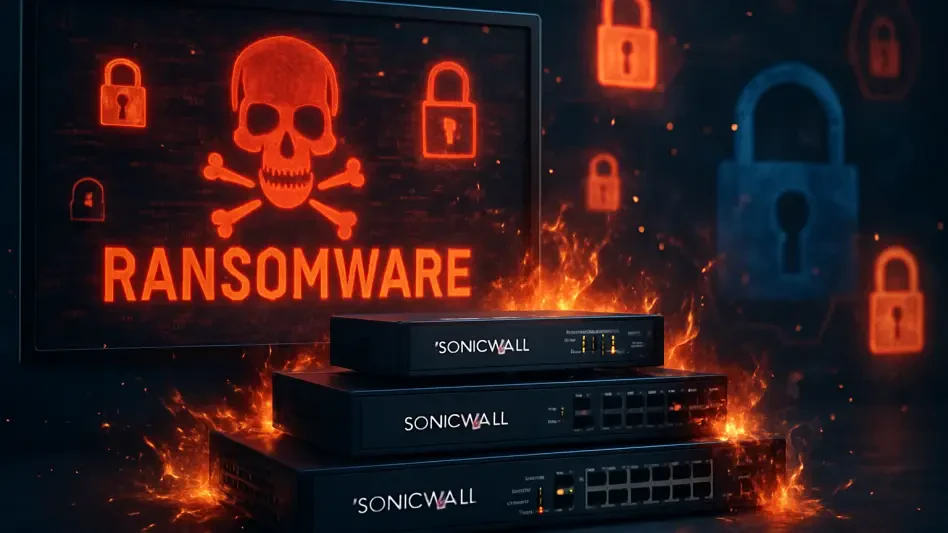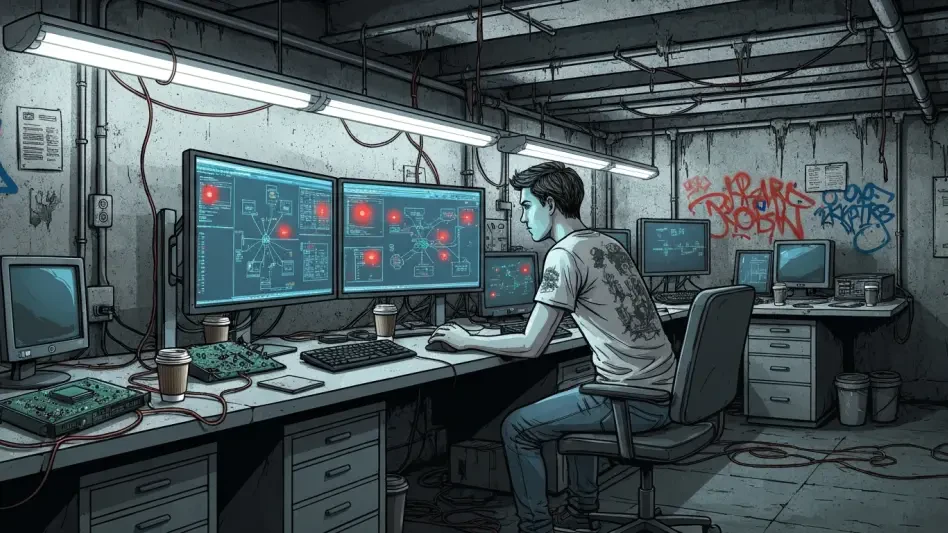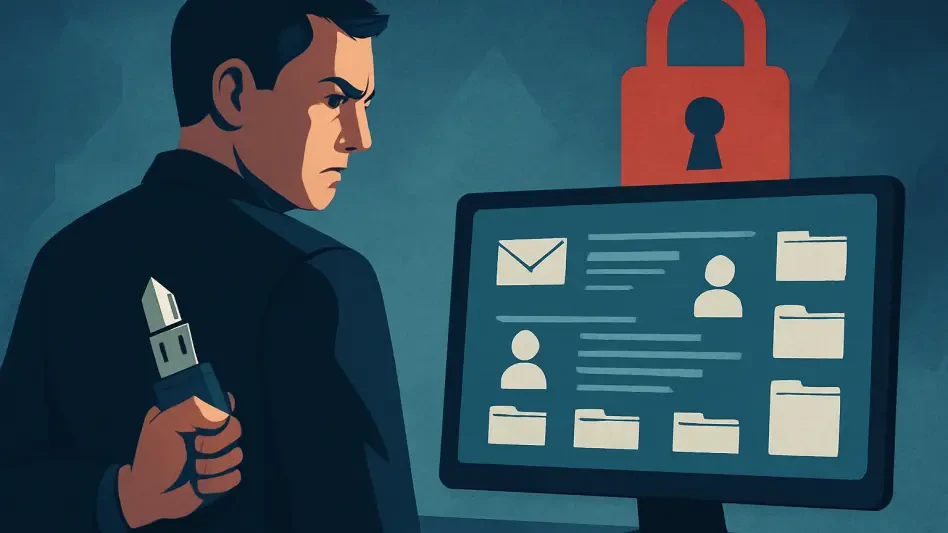What happens when a fortress meant to protect becomes the very gateway for chaos? In mid-2025, a wave of ransomware attacks targeting SonicWall Gen 7 firewalls has sent shockwaves through the cybersecurity world, exposing vulnerabilities in systems trusted by countless organizations. These breaches, driven by the notorious Akira ransomware, have reignited fears about the security of critical network defenses. With millions in extortion payments already claimed by attackers, the stakes couldn’t be higher for businesses relying on these firewalls to safeguard sensitive data. This unfolding crisis demands attention as it reveals not just technical flaws, but a deeper struggle against relentless cybercrime.
Why SonicWall Firewalls Face Renewed Threats
The resurgence of attacks on SonicWall Gen 7 firewalls, starting in mid-2025, has caught many off guard, especially since the company is no stranger to exploited vulnerabilities. Cybersecurity experts note that this latest spree, impacting fewer than 40 organizations, echoes past incidents but with a vicious twist. The Akira ransomware, known for its ruthless data theft and encryption tactics, has exploited a critical flaw, turning trusted defenses into liabilities for businesses worldwide.
This isn’t merely a technical glitch; it’s a stark reminder of the persistent nature of cyber threats. SonicWall’s firewalls, designed as robust barriers against intrusion, have appeared on the Cybersecurity and Infrastructure Security Agency’s (CISA) exploited vulnerabilities list multiple times since 2025 began. The question looms: why does this keep happening, and what does it mean for organizations caught in the crossfire of this digital warfare?
The urgency to address these breaches cannot be overstated. With Akira ransomware affiliates already extorting $42 million from over 250 organizations since early 2025, each attack chips away at trust in network security solutions. This wave serves as a critical wake-up call, pushing companies to reassess their reliance on patched systems and prompting a deeper dive into the root causes of such recurring nightmares.
The High Cost of Persistent Vulnerabilities
Beyond the immediate damage of ransomware, SonicWall’s recurring presence in vulnerability catalogs paints a troubling picture for global businesses. These firewalls are cornerstones of data protection, yet their repeated targeting by cybercriminals signals a systemic challenge. Since 2025, the company’s products have surfaced in CISA’s alerts with alarming frequency, underscoring a pattern that threatens operational stability for many.
The financial and reputational toll of these attacks is staggering. Akira ransomware alone has demonstrated its destructive potential, with victims facing not just encrypted systems but also the looming threat of leaked data if ransoms go unpaid. For small and medium-sized enterprises, a single breach can mean the difference between survival and collapse, amplifying the urgency to fortify defenses against such persistent adversaries.
This situation extends far beyond isolated incidents, reflecting a broader crisis in cybersecurity readiness. Organizations must grapple with the reality that even trusted tools can become Achilles’ heels when flaws persist or go unaddressed. The ripple effects touch everything from customer trust to regulatory compliance, making this a pivotal moment to confront the true cost of recurring vulnerabilities in critical infrastructure.
Unpacking the Attack: A Known Flaw or Something More?
At the heart of this ransomware spree lies CVE-2024-40766, a critical improper access control vulnerability in SonicOS with a CVSS score of 9.8, patched in mid-2025. SonicWall has confidently tied the attacks to this flaw, asserting that fewer than 40 organizations suffered due to lapses such as unchanged passwords during migrations from Gen 6 to Gen 7 firewalls. Yet, the Akira campaign’s tactics—stealing data and encrypting systems—raise questions about whether this explanation captures the full scope of the threat.
Doubts linger among cybersecurity researchers, particularly from Huntress, who point to anomalies that defy SonicWall’s narrative. Reports of newly installed Gen 7 devices, not just migrated ones, falling victim suggest potential additional vulnerabilities or misconfigurations at play. This discrepancy highlights a critical gap between vendor assurances and real-world outcomes, fueling debates over the true entry points exploited by attackers.
The complexity of these attacks is further compounded by user practices that amplify risk. Failure to reset credentials during system upgrades has proven a common weak link, allowing ransomware affiliates to gain footholds in otherwise patched environments. This nuanced picture reveals that while a known flaw may be the primary culprit, the interplay of human error and possible undisclosed issues cannot be ignored in assessing the breadth of this crisis.
Expert Insights on a Complex Threat Landscape
Cybersecurity professionals across the field have weighed in on this unfolding situation, offering a spectrum of perspectives that underscore its intricacy. SonicWall maintains that CVE-2024-40766 is the definitive cause, dismissing early speculation about zero-day flaws in SSL VPN protocols. Their stance is clear: this is a known issue, patched months ago, and the focus should be on user vigilance rather than undiscovered threats.
Contrasting this view, analysts at Huntress express skepticism, citing cases where patched systems and new installations still succumbed to attacks. Their observations suggest that additional factors—perhaps unpatched misconfigurations or other vulnerabilities—could be contributing to the breaches. Meanwhile, GuidePoint Security remains neutral, acknowledging SonicWall’s explanation while refraining from independent confirmation of the root cause.
Arctic Wolf adds another layer to the discussion, drawing parallels to earlier incidents involving the same flaw since 2025. Their analysis points to a recurring pattern of exploitation that challenges the notion of a fully resolved issue. These diverse expert voices collectively paint a picture of a threat landscape where certainty is elusive, and real-time attribution of attack vectors remains a daunting puzzle for even the sharpest minds in the industry.
Practical Defenses for SonicWall Users
Amid this ransomware storm, actionable steps are essential for SonicWall users aiming to protect their systems. The vendor has issued clear guidance: upgrade to SonicOS 7.3.0 for enhanced multifactor authentication and reset all credentials, particularly after migrations. These measures aim to close gaps that attackers have exploited, offering a first line of defense against unauthorized access.
Beyond vendor recommendations, monitoring for unusual activity is critical, as compromised administrator accounts could enable attackers to manipulate features like packet capture for deeper infiltration. Regular audits of system logs and access patterns can help detect early signs of intrusion, providing a window to act before damage escalates. This proactive stance is vital in an era where patched systems alone may not guarantee safety.
A layered security approach rounds out the toolkit for resilience. Employee training on phishing and password hygiene, combined with routine vulnerability assessments, can mitigate risks that technology alone cannot address. As threats like Akira evolve, SonicWall users must adopt a mindset of continuous improvement, ensuring that defenses keep pace with the ingenuity of cybercriminals targeting their networks.
Reflecting on a Battle Fought and Lessons Learned
Looking back, the ransomware attacks on SonicWall Gen 7 firewalls in 2025 served as a sobering chapter in the ongoing war against cybercrime. They exposed not only the fragility of even well-regarded security tools but also the critical role of user practices in amplifying or mitigating risks. Each breach became a stark lesson in the need for vigilance beyond patches.
Moving forward, organizations had to prioritize comprehensive strategies that blended technology with human awareness. Adopting regular system updates, enforcing strict credential policies, and fostering a culture of cybersecurity readiness emerged as non-negotiable steps. These actions aimed to rebuild trust in network defenses while preparing for the next inevitable wave of threats.
The broader industry also took note, recognizing that collaboration between vendors, researchers, and businesses was essential to outpace ransomware actors. By sharing insights and refining response mechanisms, the cybersecurity community sought to turn the tide against persistent adversaries. This collective resolve offered hope that future crises could be met with stronger, more adaptive fortifications.








